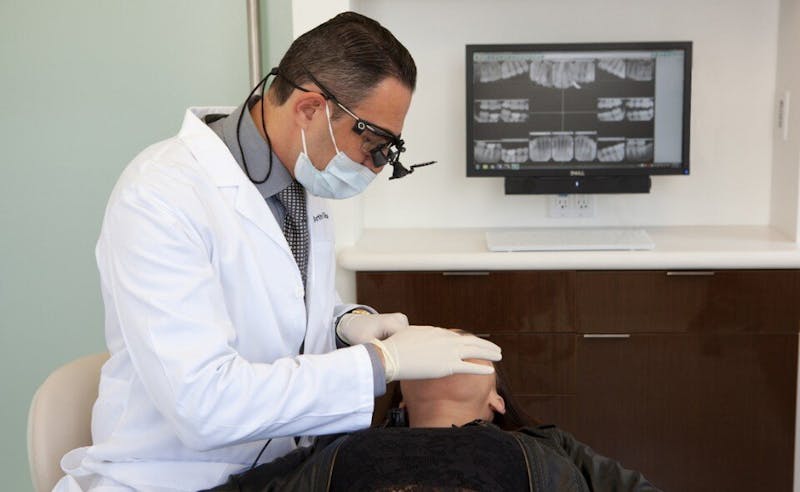
Twilight anesthesia is used for many surgical procedures, including sedation dentistry. When a cosmetic dentist elects to use twilight anesthesia (also known as conscious sedation), the patient will remain under a "light sleep," but won't be unconscious as they would with general anesthesia.
Twilight sedation is usually achieved using a medication like ketamine, fentanyl, midazolam, or valium that is administered intravenously. Alternatively, nitrous oxide (laughing gas) can be administered through a mask. The main benefits of twilight anesthesia are anxiety relief and relaxation for the patient, reduced costs, much quicker recovery times, and less (usually no) nausea and vomiting.
Twilight Sedation Explained
Twilight anesthesia is achieved using similar drugs to those that are used for general anesthesia, except in reduced amounts. Administered via gas or intravenously, drugs such as ketamine, fentanyl, valium, midazolam, and nitrous oxide (laughing gas) may be used to create a twilight sleep for patients who opt for sedation dentistry.
Levels of Twilight Anesthesia
Depending on the amount of medication used, the patient may experience light, moderate, or deep sedation. For the purposes of sedation dentistry, the level of sedation used will depend on the complexity and length of the procedure as well as the patient's anxiety level.
Light Sedation
Minimal sedation is most often used for patients who feel nervous about dental procedures, but the procedure itself is fairly quick and straightforward. With light sedation, the patient can still follow instructions and converse with the dentist and may have some memories of the procedure.
Moderate Sedation
Moderate sedation is a little deeper than light sedation. With moderate sedation, you will still be conscious but probably won't remember talking and may even drift off to sleep. This level of twilight sedation is often used for longer or more complex dental procedures.
Deep Sedation
With deep sedation, the patient is placed into a deep state of drowsiness and will often have little or no memory of the procedure. While the patient is not completely unconscious as they would be with general anesthesia, they may drift in and out of sleep. This level is most appropriate for long and complex procedures such as having multiple dental implants placed. It could also be ideal for patients who experience severe dental phobia.
Twilight Sedation Is Usually Combined With Other Techniques
Conscious sedation alone is not enough to provide pain relief during surgery. For this reason, it is always given together with regional anesthesia or a local anesthetic to block pain. For further pain relief, an analgesic medication may be combined with the anesthetic medication as an infusion or "cocktail."
For very nervous patients, some dentists may offer the patient a mild sedative such as valium (or a similar medication) to take prior to being put under sedation to help relax them. Analgesic medications are then typically taken for a few days after the surgery for pain management while the mouth heals.
Benefits of Twilight Sedation
Compared to general anesthesia, twilight sedation has several benefits for patients who need to undergo a surgical procedure, which is why it is the sedation method of choice for plastic surgeons who perform cosmetic surgery (if you get plastic surgery, make sure you choose a board-certified plastic surgeon) as well as for dental procedures.
For the patient, the main benefits of IV sedation are:
-
Increased comfort. Breathing tubes and catheters are unnecessary for this variety of anesthesia, which is a positive aspect for many patients and providers.
-
Immediate wakefulness. Unlike general anesthesia, which may knock the patient out for some time after the surgery, the twilight state ends as soon as the medication is stopped.
-
Quicker recovery period. Twilight anesthesia offers a shorter recovery time and is usually associated with less queasiness and gagging than general anesthesia, allowing patients to bounce back much quicker than with traditional treatments.
-
Lower cost. Because twilight sedation can be used in a dental office and doesn't require hospitalization, it generally comes with a much lower price tag than general anesthesia.
For dentists and plastic surgeons, twilight sedation's benefits include:
-
Easier preparation. Ventilation and catheterization are not required for twilight sleep, making the procedure quicker and more efficient.
-
Outpatient setting. Twilight anesthesia can be used in a dental office or mobile clinic, allowing professionals to perform dental surgery on the spot.
-
Possibility of interaction. Some surgical procedures require interaction with the patient. During twilight anesthesia, patients can reposition themselves for better access to different parts of the mouth.
-
Fewer risks. Because less medication is used, twilight anesthesia comes with fewer risks.
Monitoring During Twilight Sedation
Even with light sedation, it's still common for a patient's breathing to slow down, which is why every anesthesia provider is required to have specialized equipment to monitor the patient's vital signs during the dental procedure.
While your dentist will be prepared for any change in vital signs and ready to respond if anything changes, it’s important to keep in mind that issues from twilight anesthesia are extremely rare. Conscious sedation is very safe and routinely used for minor to moderate surgeries.
Enjoy Complete Peace of Mind with Sedation Dentistry
If you've been putting off a dental procedure due to fear or anxiety, sedation dentistry with twilight anesthesia could be the perfect solution. Throughout your procedure, you'll enjoy a relaxed state and absence of fear in the comfort of the dental clinic you know.
When choosing a cosmetic dentist for a surgical procedure, be sure to look for a dentist who has received the appropriate training, is a member of the American Dental Association, and has hundreds of positive independent reviews specifically attesting to their pain-free, compassionate, and anxiety-free approach. Once you find the right dentist and experience sedation dentistry for yourself, your fear of dentists will be a thing of the past.
